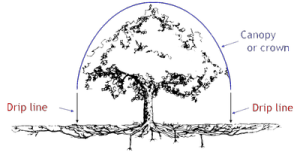By Stephen Janak
Information compiled from:
AgriLife Extension Tree Care Kit – Watering Trees
Texas A&M Forest Service – Dont Depend on Mother Nature to Water Your Drought-Stricken Trees
WHY?
Hot, dry conditions can stress trees, just like it can stress the grass in your yard. When you see your grass wilting, curling, or turning brown, your trees are being stressed as well. Trees and grass roots occupy the same place in the soil: the top 20 inches (give or take) of soil. This means tree and grass roots compete for the same water.
Because of their size, trees do not show signs of stress as quickly as the grass in your yard does. When trees are stressed from lack of water, instead of wilting or turning brown, they start consuming or killing off their smallest roots first. They do this to consume the energy which they stored in their roots during times of adequate moisture. Ever wonder why trees blow over or are uprooted during drought? It is because they have lost a large percentage of their root system, which anchors them in the soil.
Keeping trees in a healthy condition requires watering during periods of insufficient rainfall. Drought-stressed trees are more susceptible to insects, diseases, uprooting, and take longer to heal open wounds, which in turn leaves them more vulnerable to disease and pest problems.
WHEN?
Most trees are actively growing from around February to October. This is the most important time of year for trees to have adequate moisture. July, August, and September are usually the driest (and hottest) times of the year for our area. There have been years when we don’t get any rain in April, May or June either. There have also been times when we don’t receive rain during September or October.
Basically, any time from February to October that we are experiencing dry conditions, your trees can benefit from your watering. Don’t discount a tree’s need for water in October. This is an equally important time of year for trees because they are using lots of water to make energy which they will store in their roots to survive the winter.
HOW?
Trees do not benefit if you only water enough to keep the grass green. Trees require infrequent, and deep waterings. Running a sprinkler for 15 minutes per day and two days per week will not be enough water for your trees. The best way to water trees is with a soaker hose or by simply letting the hose run open-ended, without a sprinkler. Sprinklers only encourage the evaporation of water when they spray it into the air.
- During a drought, apply enough water to soak the soil to a depth of 6-8 inches. You can check the depth of soaking with a long screwdriver.
- Water once a week for darker, heavier soils, and twice a week for lighter, sandy soils.
- Apply water at the drip-line of the tree. The drip line is located under the outer reaches of the tree’s branches.

Picture from: http://ccuh.ucdavis.edu/public/drought/tree-ring-irrigation-contraption-tric-1/tree-ring-irrigation-contraption-tric
- The best time to water any plant is during the evening and at night. Trees have a chance to replenish their moisture during these hours when they are not as stressed by hot temperatures. Watering at night allows effective use of water and less evaporative loss.
HOW TO USE LESS WATER
- Reduce your watering needs by removing plants that surround your tree. Grass and trees often fight for available water. Replacing that grass — especially around new trees — with a 6-foot diameter, 2-inch deep circle of mulch can help keep moisture in the ground and available to the tree.
- Use soaker hoses instead of sprinklers, or let the hose run open-ended.
NOTE – Newly Planted Trees:
- Young, newly-planted trees should be watered three times a week. During each watering, they need 5 gallons of water for every inch of stem — or trunk — diameter, which is measured 6 inches above the ground. So if your tree measures 6 inches in diameter, that’s 30 gallons of water, three times each week.
- Water should be concentrated at the base of a new tree, which is why water bags are ideal. If you don’t have access to them, drill a few holes in the bottom of a 5 gallon bucket, place it next to the tree, fill it up and let the water slowly drain out.
- Generally, a tree is considered established about two to three years after planting, but the ongoing, extreme drought is causing some older trees to struggle. Keep a close eye on any trees planted within the last seven years.
